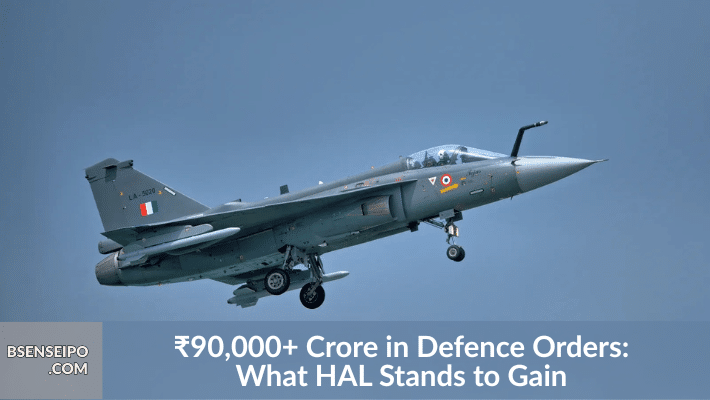HAL Bags Big with MoD: Implications for Order Book, Earnings & Indigenisation
In recent months, Hindustan Aeronautics Ltd (HAL) has secured a series of major contracts from India’s Ministry of Defence (MoD), underscoring its central role in the nation’s defence-manufacturing ambitions under the Atmanirbhar Bharat initiative. Collectively, these contracts run into well over ₹90,000 crore and cover a wide spectrum: helicopters, aero-engines, surveillance aircraft upgrades, and fleet sustainment.
Key Contracts & What They Entail
- LCH “Prachand” Helicopters (₹62,700 crore): 156 units split between IAF & Army, capable of high-altitude operations, with execution from ~2027-28 over five years. Indigenisation is central: ≧ 65% of components expected from domestic vendors, with MSME involvement and substantial job creation.
- Aero-engines for Su-30MKI (₹26,000 crore): HAL’s Koraput Division to manufacture 240 AL-31FP engines, aiming for ~54-63% indigenised content over time. This is critical for maintaining operational readiness of the Su-30 fleet.
- ALH Dhruv Mk-III helicopters (₹8,073 crore): For Army & Coast Guard; designed and developed domestically (IDDM).
- Mid-Life Upgrade of Dornier Aircraft (₹2,890 crore): Avionics and sensor upgrades for improved maritime surveillance and multi-role capabilities.
- Tejas Fighter Jet Deal (~₹66,500 crore): A massive order for 97 Tejas Mk-1A jets is expected to be finalized; if done, it would be among HAL’s largest single aircraft contracts.
Implications & Impact on HAL
Here are the major ways these deals are likely to affect HAL business, financials, strategic posture, and challenges ahead:
| Area | Positive Impacts | Possible Risks / Constraints |
|---|---|---|
| Revenue Visibility & Order Book | These recent contracts massively expand HAL’s order backlog, giving multi-year revenue visibility. Large orders like LCH, Su-30 engines, Tejas will support finances for several years. | Execution risk: delivering on time, cost overruns, supply chain delays, and capacity constraints. Large projects often run into schedule slippages. |
| Indigenisation & ‘Make in India’ Push | High indigenisation targets (60-65+%) will promote domestic vendor ecosystems, reduce import dependency, improve technology absorption. HAL’s capability will deepen. | Sourcing complexities: quality, compliance, certification of domestic components can slow progress. Some critical subsystems may still require imports, exposing risk. |
| Employment & Economic Spillover | Jobs generated directly and via MSMEs are significant; facilities at Koraput, Bengaluru, others will see sustained work leading to local economic boosts. | Managing workforce scale, maintaining skilled labour, ensuring cost efficiencies vs rising wage / raw material costs. |
| Strategic Autonomy & Defence Preparedness | These contracts help India build capacity in helicopters, aircraft engines, and fleet sustainment; reduces reliance on foreign suppliers, enhances resilience. | Technology gaps: for some systems (avionics, radar, certain engine components), India may still depend on foreign tech; global supply shocks could still disrupt. |
| Financials & Profitability | While revenues grow, margins could improve with scale, efficiencies, and indigenised content reducing input costs. Greater utilisation of assets will help. | Large CapEx may be needed for scaling production. If costs are under-estimated, or if delays happen, profitability might suffer. Also, HAL’s costs and capital structure matter. |
| Investor Sentiment & Stock Performance | Such landmark contracts tend to boost investor confidence, possibly leading to stock appreciation; also supports valuation multiples. | Expectations management is key; if market expects too much too soon, any delay or negative report can lead to correction. Fiscal, policy changes, or change of government could impact order flows. |
Key HAL-MoD Deals
- ₹62,700 crore contract for 156 LCH (Light Combat Helicopter) “Prachand”
- Two contracts: 66 LCHs for the Indian Air Force, and 90 for the Army.
- Deliveries to commence from FY 2027-28 (third year) and spread over five years.
- High altitude capabilities: designed to operate above 5,000 metres.
- Indigenous content expected ≧ 65% during execution, involving over 250 domestic companies (many MSMEs); over 8,500 direct + indirect jobs.
- ₹26,000 crore contract for 240 AL-31FP aero-engines for Su-30MKI aircraft
- Signed with HAL’s Koraput Division.
- The purpose: sustain the IAF’s Su-30MKI fleet; replace engines as life ends.
- Indigenisation targets: average content over 54%, with eventual target of ~63%.
- ₹8,073 crore contract for 34 Advanced Light Helicopters (ALH) “Dhruv Mk III”
- 25 for the Indian Army, 9 for Indian Coast Guard.
- Under the “Buy (Indian-IDDM)” category (Indian Designed, Developed & Manufactured).
- Employment and MSME involvement: over 200 MSMEs & 70 local vendors; about 190 lakh man-hours of employment.
- ₹2,890 crore contract for mid-life upgrade (MLU) of 25 Dornier aircraft
- For the Indian Navy.
- Upgrades include state-of-the-art avionics, sensors, and enhancing maritime surveillance / communication / search & rescue + secondary roles.
- Expected duration ~ 6.5 years; significant employment generation (~1.8 lakh man-days) and sourcing from indigenous sources.
- Largest-ever Tejas order imminent: ₹66,500 crore for 97 Tejas Mark-1A jets
- This is reported as likely to be inked soon.
Strategic & Wider Sectoral Impacts
- These deals signal government’s strong support for indigenous defence manufacturing and are likely to encourage private sector partnerships, technology transfer, and growth of ancillary industries.
- HAL’s role consolidates, maybe becoming even more central to future efforts (fighter aircraft programs, engine development).
- There is likely to be increasing scrutiny of execution timelines, quality, after-sales / maintenance, training, and lifecycle costs of defence platforms.




